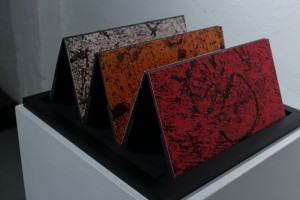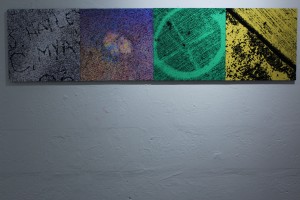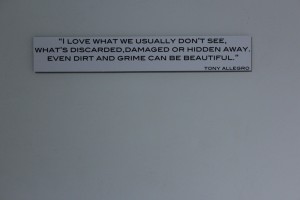Posted April 12, 2013
By NANCY CERMEÑO
University of Miami Motion Pictures Prof. Anthony Allegro exhibited his photography and experimental films at the 6th Street Container art space to a small crowd pleased with seeing something different.

Photographic images of gravel with creative color filters by Anthony Allegro exhibited at The 6th Street Container on March 30, 2013 (Photo by Nancy Cermeno).
Allegro photographed broken or vandalized concrete and gravel. His point was to show that what we step on and sometimes overlook could be beautiful.
The photographs were quite ordinary, but he made his point. Today, anything can be art. All one needs to do is put the work into context.
His experimental work with sound and video was far from ordinary. In contrast to his photography, his films were formalist works and the context was introspective, or left to interpretation by the viewer/listener.
Art is always reinventing itself. It is an endless cycle of out with the old and in with the new or the rediscovered.
The Letterists, members of an experimental film movement established in Paris in the mid-1940s by Romanian immigrant Isidore Isou, provided Allegro’s inspriation. In that era, film had become a legitimate art medium. Not only were art house films made for the masses but video installations made their way into art galleries.
Isou believed film had been thoroughly mastered and that it was time for its deconstruction.
In his first film, “Venom and Eternity,” (Isou’s manifesto) Isou says: “The break between speech and image shall form Discrepant Cinema.”
In Letterist films, the sound and the image were not in sync with each other and the sound, which consisted of words or poetry, carried the film. Isou believed the Cinema should become a species of radio, or that the novel should be injected into the Cinema.

A photographic polyptych of of concrete by Anthony Allegro at The 6th Street Container on display until April 25, 2013 (Photo by Nancy Cerneno).
Later, some Letterists, such as Guy Debord, did away with the photographic image all together.
In fact, Debord’s book “Society of a Spectacle,” was translated, word for word, into a movie of the same title.
Allegro describes his recent experimental films as “neo-Letterist.” The image puts the sound into context Most people are used to watching a movie. Allegro asks that we listen to a movie.
Allegro’s “Romance and Eternity” (2010) is an obvious reference to Isou, although they only share a similar title. In deconstructing the film, Allegro does away with narrative structure, yet the piece was richer in mood then most films.
“Romance and Eternity,” consists of shots of a street, a café, an apartment window and an anonymous female silhouette on the phone. It is the inner thoughts or memories of a young man waiting for a woman to come visit him in France. I think. I would describe the sound as being a stranger’s thoughts and the image as photographs of memory.
Besides the young man’s thought, we also hear a voicemail message that was left on Allegro’s answering machine years ago, so he weaves reality into fiction. The message is from a woman who is urging him to call her back but she remains anonymous. Then it becomes confessional as he reveals his sensual interpretation of the message.
My problem with some experimental work in all sorts of media is that sometimes it takes itself too seriously. I would not say that of Allegro’s work. It is sometimes funny and playful, but it requires you to think, see and hear something unfamiliar.
Another piece worth mentioning is “Downgrade” (2011). A shot of a faucet left dripping with the amplified sound of the water hitting the metal sink.
Then it zooms into the point where the drip falls and the sound switches to the equally incessant sound of financial analysts chattering.
The 6th Street Container is as an alternative exhibition space in Little Havana that encourages experimentation and exhibits contemporary art from the movers and shakers of Miami’s art culture.
- “Anthony T. Allegro: Recent Experimental Films and Photography.”
- March 22-April 25 at The 6th Street Container, 1155 SW 6th St., Miami, Fla. 305-560-1150.
- Mondays – Fridays: 9:30 a.m. – 1 p.m., free.
ABOUT THE IDEA OF USING EYES AND EARS SEPARATELY
The idea of using the eyes and ears separately is valued in Miami. Cinema Sounds #11 (March 30, 2013) injects the live music show into the Cinema.
Held once a year in Miami, Cinema Sounds invites bands to play along with any video of their choosing, creating a new soundtrack. The films are as diverse as the bands, from the obscure to Mel Gibson’s “Braveheart.” This type of event is new, and far from being a mastered art form, but it is appreciated.
“Nicolas Lobo: Timber, lakes,” is another experiment with multimedia and will be shown at Gallery Diet for one night, Thursday, April 11, 2013.
Lobo is known for experimenting with deconstructed pop music. Justin Timberlake’s album will be disassembled into basic components and played for visitors while they view a selection of Lobo’s recent collages and sculptures.
Experimental weekends in Miami are not hard to find, and are another aspect of its diverse cultural heritage.

